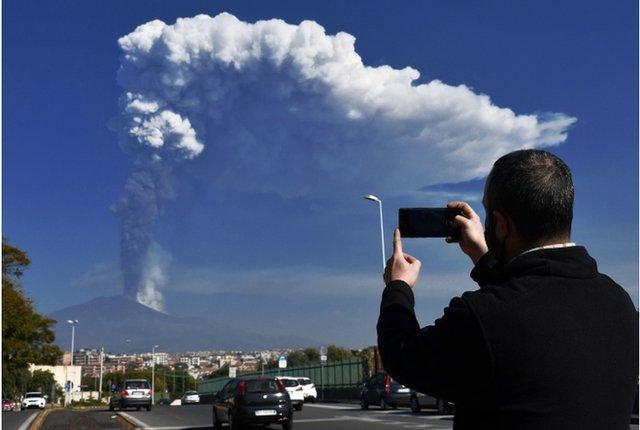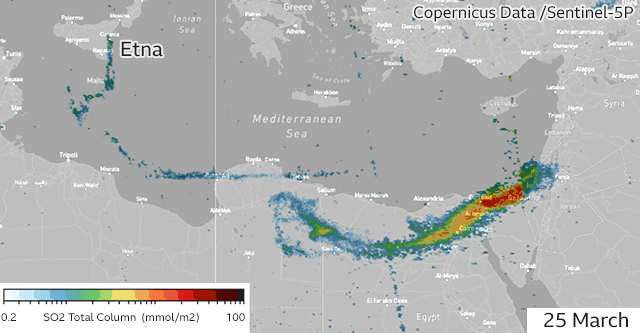The long reach of Mount Etna's gas emissions
- Published

The 3,350m-high volcano has been in explosive form since February
Recent eruptions at Europe's most active volcano, Mt Etna, have led to a spike is sulphur dioxide (SO2) emissions across the Mediterranean.
Observations from the EU's Sentinel-5P satellite have recorded plumes of the gas sweeping away from the volcano for thousands of kilometres.
One such plume even arced over the Suez canal during its blockage last month.
This had analysts at the Airbus space company incorrectly tying the SO2 to shipping - as reported by the BBC.
The suggestion was that vessels waiting to make a passage through the waterway were raising the concentration of the gas in the atmosphere locally.
This assessment has now been accepted as wrong and withdrawn.

Etna's emissions have a long reach when the mountain is in a big eruptive phase.
Located on the east coast of Sicily, the 3,350m-high volcano has been in explosive form since February.
It has been producing outpourings of lava as well as releasing large quantities of various gases.
The winds have been taking the latter south and east along the North African coast, with a plume arriving over Egypt at the end of March - just as the Ever Given container became wedged in the Suez canal.
This is what confounded Earth-observation specialists at the aerospace giant Airbus who wondered if the rise in sulphur in the region might be attributed to all the ships that were forced to park up at either end of the canal.
The analysts now accept the volcano link is the most likely cause of the sulphur spike.
Mount Etna: Volcano lights up Sicily's sky
SO2 is a byproduct of the type of heavy fuel oils burnt by ships' engines.
The International Maritime Organization (IMO) is on a drive currently to limit emissions of the gas because of the deleterious effects, external it can have on the environment and human health.
Sulphur emissions contribute to respiratory, cardiovascular and lung disease. When sulphur oxides combine with water in the atmosphere, they acidify rain which can damage crops, forests, and aquatic species.
But while the shipping industry can do something about its emissions, there is nothing that can be done to control the eruptions of a volcano.
The only practical response is to combine observations of gases from satellite with weather models to warn of affected populations of "bad air" days.
This article replaces an earlier version that incorrectly attributed the SO2 emissions over Suez to shipping.
